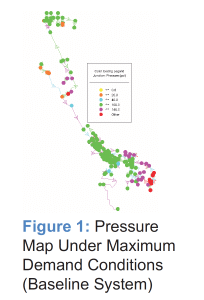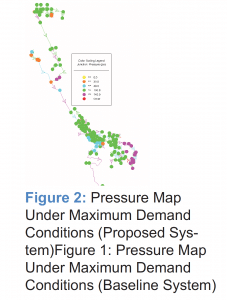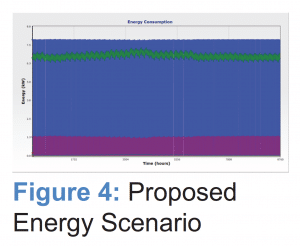Hydraulic Modeling for a Water District’s Water Distribution System
Situation
A Domestic Water Improvement District wanted to optimize its water distribution system to reduce the amount of energy used while still meeting the demands of its commercial and residential customers. Their system included eleven well pumps and three booster stations. The existing flow control for both the well and distribution pumps were manually controlled and monitored,
operating on an on-off cycling system that was not monitored by the existing Supervisory Control and Data Acquisition (SCADA) system.
The Water District requested that Lincus provide an energy assessment of their distribution system with an emphasis placed on studying the existing energy usage of their well pumps. Based on the recent pumping records provided, the production demand varied between 3-5 million-gallons-per-day (mgd) during the summer, and 2-3 mgd during the winter. In this system, well pumps first feed water into storage tanks before being distributed to customers.
The pressures between the two separate hydraulic zones were balanced by use of pressure-sustaining valves and water storage tanks. Lincus engineers reviewed the District’s distribution system and developed a dynamic and customized hydraulic model to optimize the energy consumption per million gallons (mg) of water pumped. This improved hydraulic model was able to observe operations in “real time”, integrating findings with data from the District’s geographic information system of its water distribution system. The process actively discovered opportunities for operational energy reduction daily, monthly, and seasonally.
Through its use, Lincus was able to simulate the complete operation of the District’s water distribution system and measure the impact of alternative operational controls, equipment upgrades, and the integration of the storage facilities. When reconciled with the past few years of utility billing data, the District was provided the information needed to create a baseline for overall performance, resulting in a significant savings of energy and operational costs.
Use of a similar evaluation process outside of Lincus’ model would have been manually intensive and required a great deal of engineering analysis at a much higher cost.
Solution
Based on the hydraulic model developed and reconciled for water and energy load profiles, Lincus identified three of the eleven well pumps in need of sequencing (instead of using the current on-off manual operating strategy). Since the energy intensity and loads of the pumps varied throughout the system, this new strategy would allow for speed adjustments for both the demand and existing water storage tank levels.
Lincus’ recommendations included:
1) Adjust and prioritize pump sequencing filling common reservoirs, with priority given to pumps with the lowest energy intensity that were able to meet the system demand.
2) Based on the pump test results, make improvements to wire-to-water efficiencies for three of the pumps ranging from 38-72%.
The proposed recommendations provide a total energy savings of over 58,000 kWh per year, which results in an annual utility cost savings of more than $9,300. The total cost to implement these measures was estimated to be $19,725. After taking into account the utility energy efficiency incentives of more than $6,400, the Water District’s simple payback is 1.4 years.
Figures 1 and 2 show the pressure distribution between the existing baseline system and the proposed system. As is clear from the two figures, the proposed system is resulting in a much lower pressure at the bottom of the distribution system, preventing expensive pipe blowouts and reducing water leaks within the system. The amount of water lost through a leak is directly proportional to the water pressure at that point.


Figures 3 and 4 represent energy consumption by the various pumps serving the system. Each color on the graphs represents one pump. As can be seen from the Baseline and Proposed scenarios, the suggested measures resulted in the elimination of use of one pump (light green).


Water Infrastructure and System Efficiency (WISE™) Program
The Lincus WISE program is a comprehensive, turnkey solution for municipalities which offers no-cost engineering services, project support, and cash incentives. Lincus uses a holistic approach, combining existing pump tests and hydraulic modeling to provide a detailed analysis of how water agencies pumping systems can be optimized.
For more information, please call:
(949) 244-6528